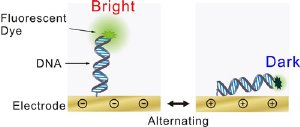Apr 22 2010
Fujitsu Laboratories Ltd. and the Technische Universität München ("TUM", Technical University Munich) today announced the joint development of a completely novel bio-sensor technology. The new technology, the first of its kind in the world, works by inducing a cyclical motion in negatively charged DNA and measuring its movement, to enable quick detection of proteins.
 Enabling visibility of DNA movement
Enabling visibility of DNA movement
The human body contains tens of thousands of different types of proteins, each playing an important role. By measuring fluctuations in proteins that are associated with certain diseases, it will be possible to offer diagnoses that are more accurate, enable earlier detection of the presence of diseases, and prescribe treatments that are more effective. As this technology can accurately measure proteins in just 1/100th the time of previous methods, it is expected to have a significant impact on health maintenance and disease prevention. With support from Fujitsu Laboratories, the team driving the technology at TUM will be commercializing it through the EXIST incubation program run by the German Federal Ministry of Economics and Technology. Business plans centered on this new technology recently won two German business plan competitions, which recognized both the advanced technical achievement behind the technology and its strong commercial potential.
What Are Proteins?
In addition to building parts of the human body, including muscles and organs, proteins play a variety of important roles in digestion, movement, disease resistance, and genetics. There are thought to be anywhere from tens of thousands to tens of millions of different types of proteins, including: antibodies that combat disease, hemoglobin found in blood, collagen which is a constituent of skin, and hair. Proteins can reveal different mechanisms when they break themselves down or work in coordination with other proteins, and are closely related to human health. Irregularities in proteins can lead to a variety of diseases.
Background
The advent of new infectious diseases, such as the H1N1 virus and sudden acute respiratory syndrome (SARS), has highlighted the importance of fast detection and accurate diagnosis in health maintenance and preventative medicine. With the success in recent years of research to determine the proteins that cause diseases such as diabetes and cancer, it is anticipated that detecting the type, amount, and size of proteins could lead to early discovery of diseases and enable appropriate treatment. This has led to efforts to develop technologies that can quickly and accurately detect proteins that act as markers for diseases.
Issues
Until now, detecting proteins has required a multi-step process that incurs high costs, in addition to a significant amount of time that was necessary to wait for test results after such tests were conducted at hospitals. Furthermore, the multi-step process required fairly large quantities of samples (such as blood) to be tested.
Overview of Newly-Developed Technology
Fujitsu Laboratories and TUM's Walter Schottky Institute(4) (Professor Dr. Abstreiter's group) have been collaborating on the development of bio-sensor technologies since 2001. The newly-developed technology, which uses DNA to measure proteins, is a completely novel approach to bio-sensor technology.
The technology has the following features:
1. An electric field acts on DNA, enabling visibility of DNA movement
Taking advantage of the characteristic that DNA in an aqueous solution is negatively charged, an electrode is cycled between positive and negative charges, which alternately attracts and repels the DNA (Figure 1). In addition, a fluorescent dye applied to the ends of the DNA allows the ends to act as reference points, shining brightly when the DNA is repelled away from the electrode and dimly when the DNA is attracted toward to the electrode, making the movement of the DNA visible.
2. Detecting and analyzing proteins
Molecules with a strong affinity for bonding with the target protein are attached to the ends of the DNA to which fluorescent dyes were applied. Once the protein bonds to the molecules, the DNA's movement becomes impeded by the protein, enabling the observation of the DNA and making it possible to determine the presence or absence of the target protein, as well as the amount of the protein that has bonded. By rapidly cycling the electrode between positive and negative charges, the bonded protein's movement can be derived, in addition to knowing the shape (size) of the protein.
Results
This bio-sensor technology is capable of accurately measuring proteins in 1/100th the time required with existing methods, and requires only 1/100 the sample volume. Furthermore, because this method can detect not only the presence of but also measure the size of proteins, it achieves higher levels of precision than with existing methods, and thus can be applied to a wide range of fields.
Future Developments
The ability to quickly and precisely measure proteins will enable doctors to quickly and accurately diagnose illnesses, as well as provide appropriate treatments within a shorter amount of time. Fujitsu Laboratories and TUM will strive for practical implementation of this technology through alliances with medical institutions.
Awards won at business plan competitions
Within the framework of the commercialization-incubation program, EXIST, run by the German Federal Ministry of Economics and Technology, TUM formed an internal team in August 2009 and is working with the support of Fujitsu Laboratories to commercialize this technology.
The TUM team entered the Munich Business Plan Competition (MBPW), mainly sponsored by the Economics and Transport Ministry of the state of Bavaria, Germany. Out of 182 entries, awards were given for the top 10 business plans, including to the TUM team. The state of Hessen in Germany also held a business plan competition (Science4Life) focusing specifically on the life sciences. As one of the top 10 teams out of 62, the TUM team was again awarded for this technology.
These awards underscore the high level of anticipation for this completely novel protein measuring technology, and its commercial potential.